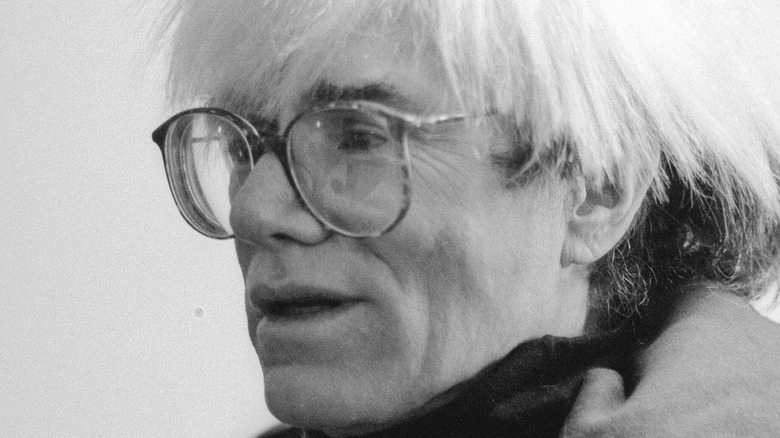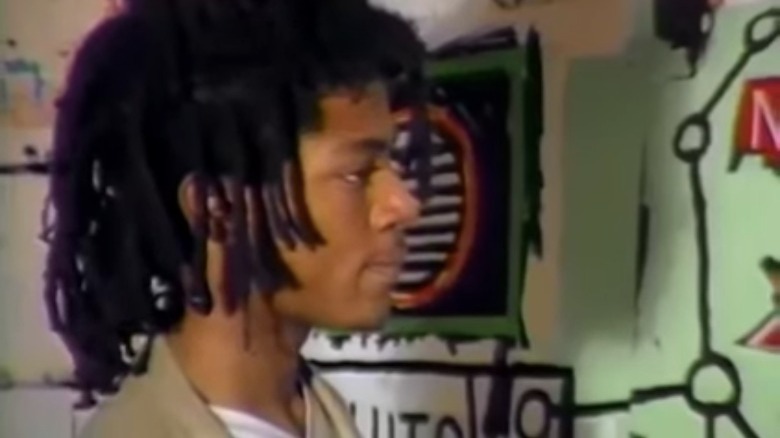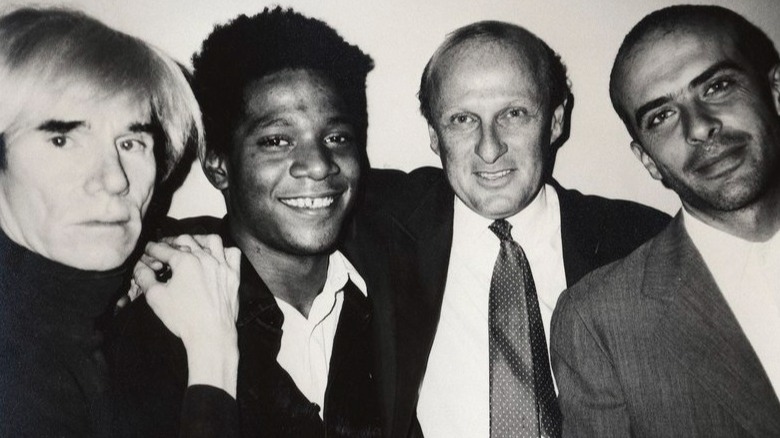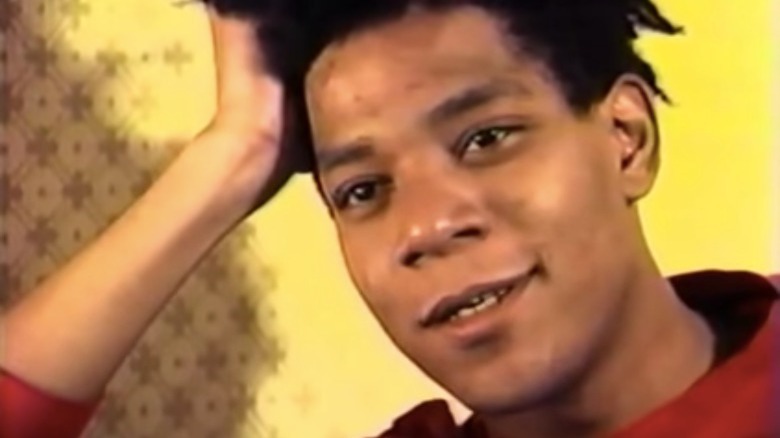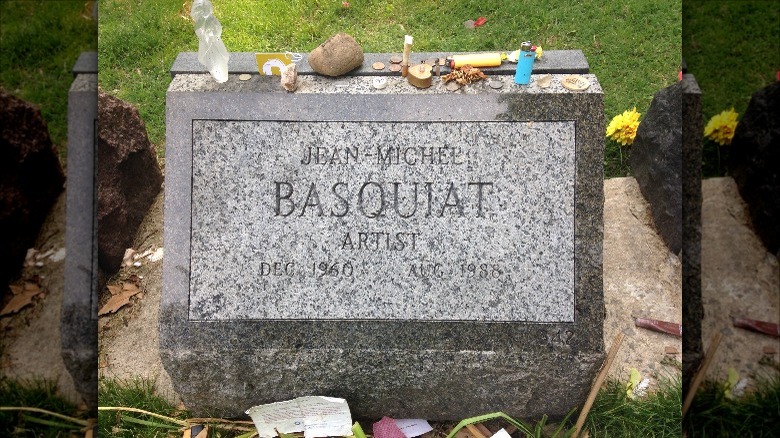Inside The Tragic Friendship Of Andy Warhol And Jean-Michel Basquiat
Whether it's literature, painting, or any other creative endeavor, it is typical for audiences to imagine that works are made by highly talented individuals acting alone. In part, this is due to the strange adoration we have in the West for the figure of the lone genius, an image that has become an archetype but which, more often than not, is also a myth.
We love the idea of artists struggling valiantly in isolation, but the fact is that great art is often the result of networking and collaboration. This is evident in the connection between two of America's most prominent modern artists of the last century — pop artist Andy Warhol and neo-expressionist graffiti master Jean-Michel Basquiat — who enjoyed more than half a decade a fruitful collaboration as well as an intensely personal relationship. In fact, their connection was such that came to define the final years of both their lives, which both ended tragically. Here are the details.
Two artists with contrasting careers
Despite coming from a comparatively comfortable middle-class family, Jean-Michel Basquiat had a troubled early life, according to The Guardian. Born in New York, his father, an accountant, was a strict disciplinarian who used to beat Basquiat and his siblings brutally, while his mother experienced mental health issues. Basquiat had an unsettled childhood, and as well as moving for two years to Puerto Rico with his father, he was eventually expelled from school at the age of 15 for covering the school principal with shaving foam. Nevertheless, he drew and painted throughout his adolescence. In the late 1970s, he was a graffiti artist eking out a living selling postcards of his work on the streets of New York, and inclusion of his work in a gallery exhibition in 1980 saw him take his first step on the ladder towards success (via Biography).
In contrast, by the early 1980s, Andy Warhol had already been an art world icon for around two decades, having made his name in the 1960s through his pioneering of pop art, which included his famous silk screenings of Marilyn Monroe and portraits of cans of Campbell's soup. He was also known for the numerous "happenings" he organized in New York that shined a spotlight on many of '60s scene's greatest talents, including The Velvet Underground and the German singer Nico, whom he convinced to collaborate.
A romanticized meeting between Warhol and Basquiat
The 1996 movie "Basquiat" — which was the directorial debut of the visual artist Julian Schnabel — was a biopic of the titular New York artist, chronicling his difficult rise to art world prominence and his tragic and untimely death. It is also a portrait of his relationship with his mentor, Andy Warhol, and Jean-Michel Basquiat's first meeting with him is recreated with rock icon David Bowie, who revels in the role of the older artist (who, incidentally, was one of Bowie's great heroes).
In the movie, Basquiat is portrayed as spotting the already famous Warhol stepping out of a limo with his friend, the art dealer Bruno Bischofberger, and heading into a New York restaurant. At his friend's insistence, Basquiat takes a stack of his postcards and enters the restaurant after Warhol, where he approaches his table and convinces the pop art pioneer to buy his "ignorant art." Warhol immediately sees the value of Basquiat's style, and soon Warhol — who isn't carrying any money of his own — is arguing playfully with Bruno for ownership of various pieces, setting the stage for his future collaboration with the young artist.
A formal introduction
Another perhaps more prosaic version of the initial meeting between Andy Warhol and Jean-Michel Basquiat has been proffered in the years since the "Basquiat" biopic first entered popular consciousness. According to Bruno Bischofberger, he was already aware of Basquiat's work — and was considering the artist in a mooted project in which adult artists collaborate with small children — when, in 1982, he purposefully invited both artists to have lunch with him and formally introduced them to one another (per the Revolver Warhol Gallery).
Per the same source, the elder artist already had brushes with Basquiat before and wasn't initially enamored with him, asking Bischofberger, "Do you really think that Basquiat is such an important artist?" and writing in his diary that the overly keen young painter was "just one of those kids that drove me crazy." However, that all changed when a polaroid was taken of Warhol and Basquiat together during a lunch. Basquiat abruptly took the photo and left the restaurant. Two hours later, Basquiat's assistant bore a fully realized painting by Basquiat of the two artists, which Bischofberger described as a "masterpiece," convincing Warhol that the young artist could join him at his legendary studio, The Factory.
A 'bromance' in the art world
According to the Revolver Warhol Gallery, Bruno Bischofberger initially envisaged a three-way collaboration between Andy Warhol, Jean-Michel Basquiat, and the renowned painter Francesco Clemente, with the three artists taking turns successively painting sections of a shared canvas and reacting to each other's contributions separately. The project went ahead, but little did Bischofberger know that Warhol and Basquiat were becoming sacred one-on-one collaborators and confidantes, who, as well as filling countless canvasses as a two-part partnership, were having radical influences on each other's art practice. Per the same source, Warhol taught the younger artist the art of silk screening, while Basquiat's confidence and freedom with the paintbrush convinced Warhol to return to painting by hand.
The two were also becoming firm friends. The deep affection between the two artists was strikingly revealed in 2019 when Michael Dayton Hermann — director of licensing at the Andy Warhol Foundation for the Visual Arts — edited a new book, "Warhol on Basquiat," which contains over 400 unseen, intimate images of the pair together, painting, lifting weights, partying, and even having their nails painted (via Vanity Fair). But though Andy Warhol and Jean-Michel Basquiat had a seismic collaboration in private, when it came to co-exhibiting their work in 1985, the art world didn't deem their joint work a success (via The Guardian). Their pieces together were derided as poor, with one critic arguing that Basquiat was nothing more than Warhol's "mascot" and a foil for the older artist to exploit as a means of remaining relevant.
The death of two icons
Jean-Michel Basquiat was hurt deeply by the public characterization of their close relationship and became withdrawn from both the public eye and from Andy Warhol. Warhol, meanwhile, was struggling with ill health. According to The New York Times, in 1987, Warhol was taken into hospital to undergo a major operation. As well as having his gallbladder removed, he also had surgery to repair an injury to his abdominal wall, which had not properly healed following his shooting by the writer Valerie Solanas in 1968. Though the operation was initially deemed a success, Warhol died unexpectedly from complications days later, on February 22, 1987, at the age of 58.
Per The Guardian, news of Warhol's death made Basquiat even more reclusive, with the artist considering giving up painting altogether and starting a new life as a producer of tequila in Hawaii. However, the artist was developing a heroin addiction, and though he headed to the islands to attempt to get clean, he returned to the drug once more when he got back to New York. He died of an overdose on August 12, 1988, eighteen months after his mentor. He was 27.
If you or anyone you know is struggling with addiction issues, help is available. Visit the Substance Abuse and Mental Health Services Administration website or contact SAMHSA's National Helpline at 1-800-662-HELP (4357).
